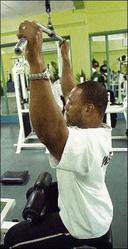
Kenneth Gardner
Beginning and intermediate weight trainers are encouraged to change their training programmes every four to six weeks. This is to ensure that you don't become bored with a set routine; boredom is a major impediment against continued progress.
Although there are many exceptions to the rule about changing your training programme, the decision is entirely up to you. I personally recommend sticking to a routine which is productive for you or at least until you get to a point where you are no longer seeing any improvements. Through constant experimentation, you will eventually learn which exercises, routines and training techniques work best for you. Once you discover what works best for you, try sticking with it until you have attained your goal.
Isolation movements
There are many ways to change to a new programme without changing the pattern of training for each muscle group. Try doing at least one to three types of basic exercises for each body part, using maximum poundage then one to three additional isolation movements (movements that stress a single muscle group) for the same muscle group. By using this process, you will be able to maintain increased muscle mass while, at the same time, refining the development of each muscle complex.
Substituting variations of particular exercises into your routine for a body part is another way of adding variety to your workout. If you started your routine by doing inclined dumbbell presses, you could mix things up the next time by doing inclined barbell presses. You may even choose to vary the width of your grip in order to put more stress on a specific muscle. Furthermore, adding variety to your workout allows you to train heavy, medium, or relatively light; change the tempo of your workout or do more or less sets or reps.
Adding variations to your routine will prevent your body from adapting to a set routine, thus allowing you to receive maximum gains from your workout. Here is a list of weight training exercise for you to do.

Excercise instructor Peter Rattray demonstrates exercising using gym equipment. - Ricardo Makyn/Staff Photographer
Oblique crunches (abdominal exercise)
Lie on your back with your knees bent and feet flat on the floor.
Slowly drop your legs to the left and let your knees rest near the floor.
Place your fingertips to the side of your head just behind your ears.
Push your lower back into the floor flattening the arch and hold.
Curl up slowly so both your shoulders lift off the floor for a few inches.
Hold for a count of two and return to the start.
Universal triceps pulldown (triceps exercise)
Place both hands on the high pulley bar (lat machine) with your palms down
and thumbs locked.
Exhale as you push the bar down until your arms are straight.
Throughout the exercise movement keep your upper arms by your sides and move only your hands and forearms.
Inhale as you allow your hands and forearms to slowly return to the starting position.
Prone leg curls (leg exercise)
Stand between bench seat and adjustable movement pad.
Lie face down with legs straight and knees just off the bench.
Grip handles lightly.
Pull movement pad to hips by contracting hamstring.
Return slowly to start.
Barbell pullovers (chest exercise)
Lie flat on your back on a flat bench.
Using an EZ Curl bar, begin by holding the bar above your chest with your elbows slightly bent.
Slowly lower the barbell, so as to stretch your arms (and the barbell), back behind your head as far as you can reach.
Return the bar to the start position slowly and repeat
Kenneth Gardner is an exercise physiologist at the G. C. Foster College of Physical Education: email: yourhealth@gleanerjm.com.

